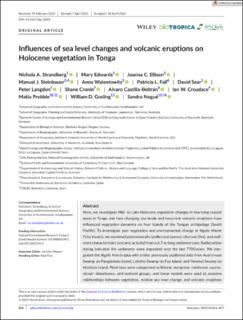Influences of sea level changes and volcanic eruptions on Holocene vegetation in Tonga
| dc.contributor.author | Strandberg, Nichola A. | |
| dc.contributor.author | Edwards, Mary E. | |
| dc.contributor.author | Ellison, Joanna C. | |
| dc.contributor.author | Steinbauer, Manuel | |
| dc.contributor.author | Walentowitz, Anna | |
| dc.contributor.author | Fall, Patricia L. | |
| dc.contributor.author | Sear, David | |
| dc.contributor.author | Langdon, Peter G. | |
| dc.contributor.author | Cronin, Shane | |
| dc.contributor.author | Castilla-Beltrán, Alvaro | |
| dc.contributor.author | Croudace, Ian W. | |
| dc.contributor.author | Prebble, Matiu | |
| dc.contributor.author | Gosling, William D. | |
| dc.contributor.author | Nogué, Sandra | |
| dc.date.accessioned | 2024-02-14T12:23:08Z | |
| dc.date.available | 2024-02-14T12:23:08Z | |
| dc.date.created | 2023-11-30T17:03:48Z | |
| dc.date.issued | 2023 | |
| dc.identifier.issn | 0006-3606 | |
| dc.identifier.uri | https://hdl.handle.net/11250/3117548 | |
| dc.description.abstract | Here, we investigate Mid- to Late-Holocene vegetation changes in low-lying coastal areas in Tonga and how changing sea levels and recurrent volcanic eruptions have influenced vegetation dynamics on four islands of the Tongan archipelago (South Pacific). To investigate past vegetation and environmental change at Ngofe Marsh (‘Uta Vava’u), we examined palynomorphs (pollen and spores), charcoal (fire), and sediment characteristics (volcanic activity) from a 6.7-m-long sediment core. Radiocarbon dating indicated the sediments were deposited over the last 7700 years. We integrated the Ngofe Marsh data with similar previously published data from Avai’o’vuna Swamp on Pangaimotu Island, Lotofoa Swamp on Foa Island, and Finemui Swamp on Ha’afeva Island. Plant taxa were categorized as littoral, mangrove, rainforest, successional/ disturbance, and wetland groups, and linear models were used to examine relationships between vegetation, relative sea level change, and volcanic eruptions (tephra). We found that relative sea level change has impacted vegetation on three of the four islands investigated. Volcanic eruptions were not identified as a driver of vegetation change. Rainforest decline does not appear to be driven by sea level changes or volcanic eruptions. From all sites analyzed, vegetation at Finemui Swamp was most sensitive to changes in relative sea level. While vegetation on low-lying Pacific islands is sensitive to changing sea levels, island characteristics, such as area and elevation, are also likely to be important factors that mediate specific island responses to drivers of change. | en_US |
| dc.language.iso | eng | en_US |
| dc.publisher | Wiley | en_US |
| dc.rights | Navngivelse 4.0 Internasjonal | * |
| dc.rights.uri | http://creativecommons.org/licenses/by/4.0/deed.no | * |
| dc.title | Influences of sea level changes and volcanic eruptions on Holocene vegetation in Tonga | en_US |
| dc.type | Journal article | en_US |
| dc.type | Peer reviewed | en_US |
| dc.description.version | publishedVersion | en_US |
| dc.rights.holder | Copyright 2023 The Author(s) | en_US |
| cristin.ispublished | true | |
| cristin.fulltext | original | |
| cristin.qualitycode | 1 | |
| dc.identifier.doi | 10.1111/btp.13231 | |
| dc.identifier.cristin | 2206847 | |
| dc.source.journal | Biotropica | en_US |
| dc.source.pagenumber | 816-827 | en_US |
| dc.identifier.citation | Biotropica. 2023, 55 (4), 816-827. | en_US |
| dc.source.volume | 55 | en_US |
| dc.source.issue | 4 | en_US |
Tilhørende fil(er)
Denne innførselen finnes i følgende samling(er)
-
Department of Biological Sciences [2279]
-
Registrations from Cristin [10237]

